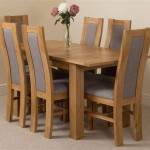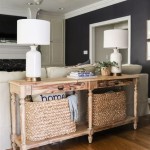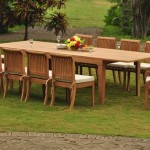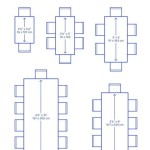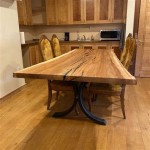The Grandeur and Practicality of Dining Room Tables Seating 20
The concept of a dining room table capable of seating 20 individuals might initially evoke images of lavish banquets in grand estates or the bustling atmosphere of a commercial restaurant. However, the reality is that such tables, while undoubtedly large, can serve a variety of purposes in both residential and commercial settings. The decision to invest in a dining room table of this scale requires careful consideration of space, usage, and design.
A dining table intended for 20 people isn't a standard item readily found in most furniture stores. It usually necessitates custom design and fabrication. This presents an opportunity to tailor the table to the specific needs and aesthetic preferences of the buyer. Materials, dimensions, and overall style can be meticulously chosen to create a centerpiece that is both functional and visually appealing.
Before delving into the specifics of design and construction, it is crucial to acknowledge the logistical challenges associated with accommodating such a large piece of furniture. The space required is substantial. A room that comfortably houses a standard-sized dining table will likely feel cramped and cluttered with a table designed for 20. Careful measurements and spatial planning are paramount to ensure adequate room for movement and comfortable seating for all guests.
The purpose of this article is to explore the various aspects of dining room tables that seat 20, from their applications and design considerations to the materials used in their construction and the potential logistical challenges involved. It aims to provide a comprehensive overview for individuals or organizations considering such a purchase.
Applications and Use Cases
Dining room tables seating 20 are not limited to purely residential applications. While they can certainly be used in large homes for hosting elaborate dinner parties or family gatherings, they also find utility in commercial settings and institutional environments. Understanding the intended use is crucial for determining the appropriate design and functionality of the table.
In a residential setting, a table of this size might be situated in a dedicated dining room or a large open-plan living area. It could be used for frequent family meals in large households, or reserved for special occasions such as holiday celebrations, birthdays, and anniversaries. The table could also serve as a focal point for social gatherings, providing ample space for guests to interact and enjoy each other's company.
Commercial applications include restaurants specializing in group dining, corporate meeting rooms, and event spaces. Restaurants may use these tables to accommodate large parties, encouraging a communal dining experience. Corporate meeting rooms can benefit from a large table that facilitates collaborative work and presentations. Event spaces often utilize such tables for banquets, conferences, and other large-scale gatherings.
Institutional environments, such as universities, boarding schools, and retirement communities, also have a need for large dining tables. These tables can facilitate communal meals and social interaction among residents or students. The design in these settings often prioritizes durability and ease of maintenance.
Regardless of the setting, the primary function of the table remains consistent: to provide a comfortable and accessible surface for dining, working, or socializing. The specific design and features, however, will vary depending on the intended use and the overall aesthetic of the space.
Design and Construction Considerations
Designing a dining room table for 20 people is a complex undertaking that requires careful consideration of various factors. These include the overall shape and dimensions of the table, the materials used in its construction, the style and aesthetic, and the structural integrity necessary to support its size and weight.
The shape of the table is a fundamental design element. Rectangular and oval tables are the most common choices for seating large groups, as they provide ample space for diners along the sides. Round tables, while aesthetically pleasing, are generally less practical for seating 20 people due to the large diameter required and the potential for difficulty in reaching the center of the table. Square tables can be used, but they are often less efficient in terms of space utilization.
The dimensions of the table must be carefully calculated to ensure adequate legroom and elbow room for each diner. A general guideline is to allow approximately 24 inches of width per person. Therefore, a table seating 20 people would ideally be at least 40 feet in perimeter. The actual dimensions may vary depending on the specific design and the size of the chairs used.
The choice of materials is crucial for both aesthetic appeal and structural integrity. Hardwoods, such as oak, maple, and walnut, are popular choices for their durability and natural beauty. Softwoods, such as pine, can be used, but they may require additional reinforcement. Metal frames can provide a strong and stable base, particularly for larger tables. Table tops can also be constructed from materials like glass, stone, or manufactured composites. Each material offers different aesthetic qualities and levels of durability.
The style of the table should complement the overall aesthetic of the room. A traditional dining room might benefit from a table with ornate carvings and a rich wood finish. A modern dining room might be better suited to a sleek, minimalist table with clean lines and a simple finish. The design should also consider the style of the chairs that will be used with the table.
Structural integrity is paramount for a table of this size. The table must be able to support the weight of the table top, the legs, and the diners without sagging or wobbling. This requires careful engineering and the use of high-quality materials. Reinforcements, such as crossbeams and metal braces, may be necessary to ensure stability.
Logistical Challenges and Solutions
Acquiring and installing a dining room table that seats 20 presents several logistical challenges that must be addressed. These challenges range from transportation and installation to maintenance and storage. Careful planning and preparation are essential to overcome these obstacles.
Transportation is a significant challenge due to the size and weight of the table. It may be necessary to hire a specialized moving company with experience in handling large and delicate furniture. The table may need to be disassembled for transport and reassembled on site. Adequate access to the room where the table will be placed is crucial, including wide doorways and clear pathways.
Installation can be a complex process, particularly for custom-built tables. Professional installation is often recommended to ensure that the table is properly assembled and securely positioned. The floor must be level to prevent the table from wobbling. Adjustments may be necessary to ensure that the table is perfectly aligned.
Maintenance is an ongoing consideration. Large tables are susceptible to scratches, spills, and other forms of damage. Regular cleaning and polishing are necessary to maintain the table's appearance. Protective measures, such as tablecloths or placemats, can help to prevent damage. The appropriate cleaning products and techniques will vary depending on the materials used in the table's construction.
Storage can be a challenge when the table is not in use. If the table is only used for occasional events, it may be necessary to store it in a separate room or storage facility. Disassembly may be required for storage. Proper storage conditions are essential to prevent damage from moisture, heat, or pests.
Addressing these logistical challenges requires careful planning and a proactive approach. Working with experienced professionals, such as furniture movers and installers, can help to ensure a smooth and successful outcome. Investing in high-quality materials and proper maintenance can prolong the life of the table and protect its value.
In conclusion, a dining room table seating 20 represents a significant investment and a unique design challenge. By carefully considering the applications, design considerations, and logistical challenges involved, it is possible to create a functional and visually stunning centerpiece that will serve as a focal point for gatherings for years to come. The scale of the table necessitates a thorough assessment of needs and resources to ensure the final product meets expectations and performs its intended function effectively.

20 Seater Dining Table

Large Dining Table That Seats 20 Or More Italy By Web

20 Seater Dining Table

Pin Page

Large 24 Foot Mahogany Extension Dining Table Seats 30

10 12 14 16 18 20 Seater Dining Table 2 Oak Planked Top Triple Infinite Opt N Ebay

Large Dining Tables 12 20 Seats Countryside Amish Furniture

Boundless 18 Seater Dining Table Seats Up To 20 People Buy Now

Rustic Hand Carved Lodge Table Solid Wood With Matching Chairs

Studio 20 Dining Table Palmetto Home

